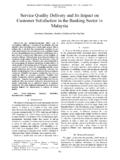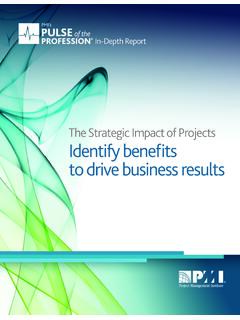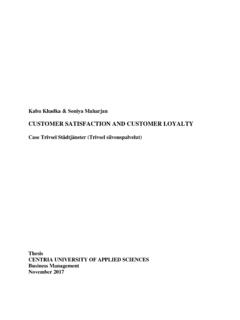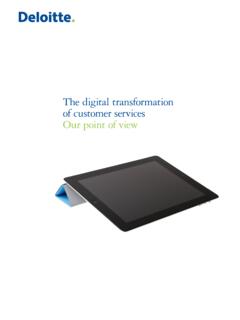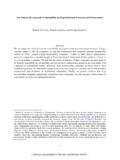Transcription of New IFRS 16 Leases standard | The impact on business …
1 New IFRS 16 Leases standard | The impact on business valuation - New IFRS 16 Leases standard The impact on business valuation 0. New IFRS 16 Leases standard | The impact on business valuation Contents Introduction 3. Key impact on financials and ratios 4. impact on valuations 6. Conclusion 10. 01. New IFRS 16 Leases standard | The impact on business valuation The introduction of IFRS 16 Leases will lead to an increase in leased assets and financial liabilities on the balance sheet of the lessee. What is the impact on business valuation ?
2 2. New IFRS 16 Leases standard | The impact on business valuation Introduction The introduction of IFRS 16 Leases will lead to an increase in leased assets and financial liabilities on the balance sheet of the lessee, while EBITDA of the lessee increases as well. Accordingly, companies with material off-balance sheet lease commitments will encounter significant changes in their key financial metrics such as leverage ratio, return on invested capital (ROIC) and valuation multiples. Although equity values should not change, enterprise values of companies will increase.
3 Furthermore, although accounting policies should not affect economic valuations, we foresee that IFRS 16 will impact the outcomes of valuations and introduce new attention areas in business valuation and M&A transactions. The International Accounting standards Board (IASB) issued IFRS 16 Leases in January 2016, effective for financial periods beginning on or after 1 January 2019. IFRS 16 replaces the previous Leases standard , IAS 17 Leases , and related Interpretations. IFRS 16 sets out the principles for the recognition, measurement, presentation and disclosure of Leases for both parties to a contract, the customer ( lessee') and the supplier ( lessor').
4 Currently, based on IAS 17, Leases shall be classified as either finance Leases or operating Leases depending on whether a lease is economically similar to purchasing the asset that is being leased: A finance lease is defined as a lease that transfers substantially all the risks and rewards incidental to ownership to the lessee. Legal title may or may not eventually be transferred. Conversely, an operating lease is defined as a lease that does not transfer substantially all the risks and rewards incidental to ownership from the lessor to the lessee.
5 03. New IFRS 16 Leases standard | The impact on business valuation Key impact on financials and ratios Under IFRS 16 a lessee will no longer make a distinction between finance Leases and operating Leases ; all (material). Leases will be treated as finance Leases , with the exception of short-term Leases and low value Leases . In the statement of financial position, the lessee will recognize the asset and the liability for the lease, while in the statement of profit and loss, the lessee will recognize the interest cost and the depreciation of the leased asset instead of the operating lease expenses.
6 The new accounting treatment will lead to: An increase in net debt. Research on 50 Dutch publicly-listed companies indicates that their combined net debt grows by some EUR 45 billion1. This represents an increase in net debt of approximately 30%. We even observe that for 9 out of 50 companies the increase of net debt is over 50%. A higher EBITDA2. EBIT(A) will also increase, however less substantial, as the majority of the former rental expenses will be reflected in depreciation. A higher invested capital for the lessee. This generally lowers ROIC.
7 1. Based on an assessment of the operational lease obligations of the largest 50 publicly-listed Dutch companies included in the AEX, AMX and ASCX (excluding financials and real estate companies). Assuming a remaining lease duration for each company based on the total remaining lease obligation, divided by the 2016 lease obligation and assuming a discount rate of 5%. 2. The combined 2015 EBITDA of the sample increases by some EUR 10bn (15%). 04. New IFRS 16 Leases standard | The impact on business valuation A substantial variance is observed in the sample.
8 The impact on net debt and EBITDA is obviously the largest for companies with many operating Leases , for example in sectors like retail & wholesale and transportation (including Ahold, AirFranceKLM and GrandVision). We also observe - on average an increase in net debt / EBITDA ratios. The impact depends on the remaining duration of the lease (and current leverage ratio). The incremental net debt / EBITDA on the lease liability will generally be high at start of the lease term, gradually decreasing to zero at the end of the lease term.
9 We estimate a increase in the average leverage ratio of the 50 publicly-listed Dutch companies (please see graph below). Net debt / EBITDA 2016. + + + + + + + Retail & Wholesale Food & Manufacturing Tranportation, TMT IT & professional Total sample Consumer Goods Diversified Construction & Services Engineering Services IAS 17 IFRS 16. Source: Bloomberg, annual reports, Deloitte analysis Note: based on median observation within group 05. New IFRS 16 Leases standard | The impact on business valuation impact on valuations The introduction of IFRS 16 should in principle have no DCF approach impact on fundamental valuations, since the substance As said, IFRS 16 will increase the enterprise value of of the lease does not change the economics and cash companies as net debt will increase, while equity value flow generating capacity of the business .
10 However, we should remain the same. In DCF models in which expect that IFRS 16 will eventually impact the outcomes enterprise values are assessed based on the NPV of of valuations. expected Free Cash Flows (FCF) this will generally be reflected via the following two effects: Following IFRS 16 leverage ratios4 of (peer group). companies, which are used to estimate the target capital structure in the WACC, will increase. A higher leverage, with unchanged observed levered beta's5, will lead to a lower WACC and a higher net present value of FCF's; and After IFRS 16, the future FCF's will be higher over the remaining lease period, as rental expenses are excluded from EBITDA and hence FCF.










